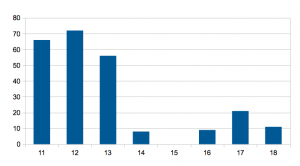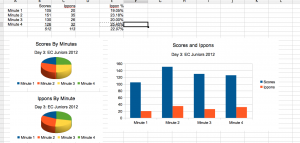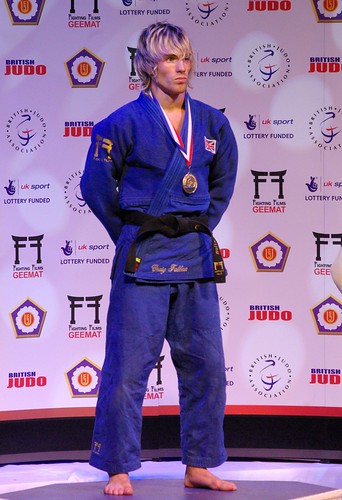Today was the heavier weights here in Qingdao, so when looking at the data perhaps there is a difference in the pattern to that from day one?
Day 2 (-70, -78, +78, -81, -90, -100, +100), Opening Rounds:
Total Scores: 139
Scores in 1st minute: 21
Scores in 2nd minute: 34
Scores in 3rd minute: 34
Scores in 4th minute: 37
Scores in 5th minutes: 13
Ippon scores in 1st minute: 6
Ippon scores in 2nd minute: 6
Ippon scores in 3rd minute: 9
Ippon scores in 4th minute: 10
Ippon scores in 5th minutes: 5
Day 2 (-70, -78, +78, -81, -90, -100, +100), Gold Medal Fights:
Total Scores: 19
Scores in 1st minute: 1
Scores in 2nd minute: 4
Scores in 3rd minute: 4
Scores in 4th minute: 6
Scores in 5th minutes: 4
Ippon scores in 1st minute: 1
Ippon scores in 2nd minute: 0
Ippon scores in 3rd minute: 1
Ippon scores in 4th minute: 2
Ippon scores in 5th minutes: 2
It is also worth noting that the numbers quoted here include all changes to the IJF scoreboards, so includes scores later changed. The minute times mentioned include the golden score as well; so again care must be taken when interpreting the numbers. All this data is included in a database should people be interested in doing some research and analysis.
Of course this is a small sample, but it is interesting none the less to look at the numbers and especially to look at the differences between light and heavy. We need to consider also where we are in the Olympic cycle and how that affects the players attending the event and the level of preparation and focus they might have on the day.
Your comments on this are invited and appreciated.
Preliminary rounds, results:
GP_CHN2012 -100kg Mat:2 2:57 NUNES, Renan (BRA) 100(1)-000(0) DORJ, Anar (MGL)
GP_CHN2012 -100kg Mat:2 2:50 BAUZA, Karolis (LTU) 100(1)-000(0) XU, Xin (CHN)
GP_CHN2012 -81 kg Mat:1 2:04 KHABACHIROV, Murat (RUS) 001(1)-000(1) CHO, Seung Kwon (KOR)
GP_CHN2012 -70 kg Mat:3 0:58 CHEN, Yun-Ting (TPE) 100(0)-000(0) KAUR, Gagandeep (IND)
GP_CHN2012 -100kg Mat:2 2:28 ASANUMA, Takumi (JPN) 000(0)-100(0) XU, Jie (CHN)
GP_CHN2012 -70 kg Mat:3 1:51 MERLI, Nadia (BRA) 000(0)-100(0) OSUMI, Yuka (JPN)
GP_CHN2012 -100kg Mat:2 2:14 MAGOMEDOV, Shamil (RUS) 001(1)-100(2) KIM, Do Hyoung (KOR)
GP_CHN2012 -81 kg Mat:1 0:00 OTGONBAATAR, Uuganbaatar (MGL) 011(0)-000(0) EBI, Yasuhiro (JPN)
GP_CHN2012 -70 kg Mat:3 4:08 VARGAS KOCH, Laura (GER) 110(0)-000(0) CHEN, Rong (CHN)
GP_CHN2012 -81 kg Mat:1 4:24 DAVIS, Thomas (GBR) 100(0)-000(0) GAO, Haiyuan (CHN)
GP_CHN2012 -100kg Mat:2 1:46 CORREA, Luciano (BRA) 100(0)-000(1) ZHAO, Dongming (CHN)
GP_CHN2012 -81 kg Mat:1 3:06 PENALBER, Victor (BRA) 101(0)-000(2) KUMAR, Manoj (IND)
GP_CHN2012 -100kg Mat:2 3:52 KUMAR, Pramod (IND) 000(0)-100(0) KUMASHIRO, Yusuke (JPN)
GP_CHN2012 -70 kg Mat:3 0:00 HAN, Weiyan (CHN) 010(1)-000(3) YOU, Mee Won (KOR)
GP_CHN2012 -81 kg Mat:1 2:23 WU, Wen Shun (TPE) 000(0)-101(0) WANG, Xuewen (CHN)
GP_CHN2012 -100kg Mat:2 3:56 YUAN, Jinling (CHN) 100(0)-000(0) HONG, Yi Chih (TPE)
GP_CHN2012 -81 kg Mat:1 2:42 GAN, Tuvshinjargal (MGL) 101(0)-000(2) TURABOEV, Bekzod (UZB)
GP_CHN2012 -100kg Mat:2 1:14 LIM, Seung Rok (KOR) 000(1)-100(1) HUSSAIN, Shah (PAK)
GP_CHN2012 -78 kg Mat:1 4:01 YANG, Xiuli (CHN) 001(0)-100(0) HIDAKA, Misaki (JPN)
GP_CHN2012 -70 kg Mat:3 0:00 TSEND AYUSH, Naranjargal (MGL) 000(1)-000(0) ZHOU, Chao (CHN)
GP_CHN2012 -90 kg Mat:2 2:25 SINGH, Avtar (IND) 000(1)-100(0) ZHANG, Jun (CHN)
GP_CHN2012 -78 kg Mat:1 1:13 ZHANG, Jie (CHN) 100(0)-000(0) HSU, Hsin-Mei (TPE)
GP_CHN2012 -78 kg Mat:1 4:04 VELENSEK, Anamari (SLO) 100(0)-000(0) CHEN, Ying (CHN)
GP_CHN2012 -78 kg Mat:1 3:15 WANG, Szu-Chu (TPE) 000(0)-100(0) HAN, Li (CHN)
GP_CHN2012 -70 kg Mat:3 0:15 POGACNIK, Anka (SLO) 001(0)-110(1) TAKAHASHI, Rui (JPN)
GP_CHN2012 -90 kg Mat:2 0:00 KIM, Kwang-Ho (KOR) 001(1)-000(2) ZHANG, Zhongbo (CHN)
GP_CHN2012 -81 kg Mat:1 2:18 KHABACHIROV, Murat (RUS) 111(0)-000(0) ZHANG, Wentao (CHN)
GP_CHN2012 -100kg Mat:2 1:43 NUNES, Renan (BRA) 100(1)-000(0) BAUZA, Karolis (LTU)
GP_CHN2012 +100kg Mat:3 0:30 ULZIIBAYAR, Duurenbayar (MGL) 000(0)-100(0) WANG, Quanchao (CHN)
GP_CHN2012 +78 kg Mat:3 5:00 QIN, Qian (CHN) 100(0)-000(0) WOO, Jung-Min (KOR)
GP_CHN2012 -100kg Mat:2 1:53 XU, Jie (CHN) 000(2)-101(0) KIM, Do Hyoung (KOR)
GP_CHN2012 -81 kg Mat:1 1:35 OTGONBAATAR, Uuganbaatar (MGL) 001(0)-000(2) DAVIS, Thomas (GBR)
GP_CHN2012 +78 kg Mat:3 0:00 WANG, Rui (CHN) 002(1)-000(0) ICHIHASHI, Suzuka (JPN)
GP_CHN2012 -81 kg Mat:1 0:00 PENALBER, Victor (BRA) 001(0)-000(2) WANG, Xuewen (CHN)
GP_CHN2012 -100kg Mat:2 0:00 CORREA, Luciano (BRA) 000(2)-001(0) KUMASHIRO, Yusuke (JPN)
GP_CHN2012 +78 kg Mat:3 0:00 ALTHEMAN, Maria Suelen (BRA) 000(2)-002(0) LI, Yang (CHN)
GP_CHN2012 -100kg Mat:2 2:43 YUAN, Jinling (CHN) 101(0)-000(0) HUSSAIN, Shah (PAK)
GP_CHN2012 -81 kg Mat:1 1:57 GAN, Tuvshinjargal (MGL) 001(1)-100(2) LI, Maojian (CHN)
GP_CHN2012 -70 kg Mat:3 1:52 PORTELA, Maria (BRA) 100(0)-000(1) CHEN, Yun-Ting (TPE)
GP_CHN2012 -90 kg Mat:2 3:49 SULEMIN, Grigorii (RUS) 002(4)-100(0) ZHANG, Jun (CHN)
GP_CHN2012 -90 kg Mat:2 0:54 LI, Kunpeng (CHN) 000(0)-101(0) HUH, Chae Goo (KOR)
GP_CHN2012 -78 kg Mat:1 0:00 HIDAKA, Misaki (JPN) 001(0)-000(2) CHOI, Mi-Young (KOR)
GP_CHN2012 -70 kg Mat:3 0:00 OSUMI, Yuka (JPN) 000(1)-100(1) VARGAS KOCH, Laura (GER)
GP_CHN2012 -90 kg Mat:2 0:00 KIM, Kwang-Ho (KOR) 001(1)-000(2) LKHAGVASUREN, Otgonbaatar (MGL)
GP_CHN2012 -78 kg Mat:1 1:29 JUNG, Da Woon (KOR) 010(1)-000(1) ZHANG, Jie (CHN)
GP_CHN2012 -78 kg Mat:1 4:44 VELENSEK, Anamari (SLO) 100(0)-000(0) CHONGTHAM, Jina Devi (IND)
GP_CHN2012 -70 kg Mat:3 0:54 CHEN, Fei (CHN) 001(1)-000(2) HAN, Weiyan (CHN)
GP_CHN2012 -90 kg Mat:2 0:00 CHENG, Xunzhao (CHN) 010(1)-001(0) KITANO, Yuichi (JPN)
GP_CHN2012 -78 kg Mat:1 1:47 POWELL, Natalie (GBR) 010(1)-100(0) HAN, Li (CHN)
GP_CHN2012 -70 kg Mat:3 3:15 ZHOU, Chao (CHN) 100(0)-000(0) TAKAHASHI, Rui (JPN)
GP_CHN2012 +100kg Mat:3 1:42 PASKEVICIUS, Marius (LTU) 100(0)-000(0) WANG, Zhen (CHN)
GP_CHN2012 +100kg Mat:3 4:08 WANG, Quanchao (CHN) 100(0)-000(0) LEE, Po Yen (TPE)
GP_CHN2012 +100kg Mat:3 0:00 SAIDOV, Renat (RUS) 001(1)-000(2) SHEN, Zhuhong (CHN)
GP_CHN2012 +100kg Mat:3 1:05 KIM, Soo-Whan (KOR) 000(2)-001(1) WANG, Qiang (CHN)
Semifinals:
GP_CHN2012 -81 kg Mat:2 0:46 KHABACHIROV, Murat (RUS) 001(0)-000(1) OTGONBAATAR, Uuganbaatar (MGL)
GP_CHN2012 -81 kg Mat:2 2:00 PENALBER, Victor (BRA) 100(0)-000(0) LI, Maojian (CHN)
GP_CHN2012 -70 kg Mat:2 2:29 PORTELA, Maria (BRA) 002(0)-001(0) VARGAS KOCH, Laura (GER)
GP_CHN2012 -70 kg Mat:2 0:00 CHEN, Fei (CHN) 010(1)-000(3) ZHOU, Chao (CHN)
GP_CHN2012 -90 kg Mat:2 0:00 ZHANG, Jun (CHN) 001(0)-000(1) HUH, Chae Goo (KOR)
GP_CHN2012 -90 kg Mat:2 2:36 KIM, Kwang-Ho (KOR) 000(0)-100(1) CHENG, Xunzhao (CHN)
GP_CHN2012 -78 kg Mat:2 0:51 HIDAKA, Misaki (JPN) 000(2)-001(0) JUNG, Da Woon (KOR)
GP_CHN2012 -78 kg Mat:2 4:24 VELENSEK, Anamari (SLO) 100(0)-000(0) HAN, Li (CHN)
GP_CHN2012 -100kg Mat:2 0:00 NUNES, Renan (BRA) 002(0)-001(1) KIM, Do Hyoung (KOR)
GP_CHN2012 -100kg Mat:2 0:00 KUMASHIRO, Yusuke (JPN) 001(1)-000(0) YUAN, Jinling (CHN)
GP_CHN2012 +78 kg Mat:2 2:54 QIN, Qian (CHN) 101(0)-000(0) WANG, Rui (CHN)
GP_CHN2012 +78 kg Mat:2 0:00 LI, Yang (CHN) 000(2)-001(1) YU, Song (CHN)
GP_CHN2012 +100kg Mat:2 2:09 PASKEVICIUS, Marius (LTU) 110(0)-000(1) WANG, Quanchao (CHN)
GP_CHN2012 +100kg Mat:2 0:00 SAIDOV, Renat (RUS) 010(2)-001(3) WANG, Qiang (CHN)
Gold Medal Fights:
GP_CHN2012 -81 kg Mat:2 2:43 KHABACHIROV, Murat (RUS) 000(0)-100(0) PENALBER, Victor (BRA)
GP_CHN2012 -70 kg Mat:2 1:59 PORTELA, Maria (BRA) 000(1)-100(1) CHEN, Fei (CHN)
GP_CHN2012 -90 kg Mat:2 1:27 ZHANG, Jun (CHN) 000(1)-100(1) CHENG, Xunzhao (CHN)
GP_CHN2012 -78 kg Mat:2 0:00 JUNG, Da Woon (KOR) 000(2)-102(0) VELENSEK, Anamari (SLO)
GP_CHN2012 -100kg Mat:2 4:41 NUNES, Renan (BRA) 000(0)-100(0) KUMASHIRO, Yusuke (JPN)
GP_CHN2012 +78 kg Mat:2 0:00 QIN, Qian (CHN) 000(1)-000(1) YU, Song (CHN)
GP_CHN2012 +100kg Mat:2 0:04 PASKEVICIUS, Marius (LTU) 110(2)-001(1) SAIDOV, Renat (RUS)







 This chart shows when the scores that won the matches occured in the -60kg category of the 2008 Prague World Cup. From this we can infer that the period from 211 seconds through 300 seconds is the “hotspot” at which point you are at the greatest risk of being scored against (or of course you have the greatest opportunity for scoring). Players can be trained (potentially) using methods that capitalise on this identified “hotspot”.
This chart shows when the scores that won the matches occured in the -60kg category of the 2008 Prague World Cup. From this we can infer that the period from 211 seconds through 300 seconds is the “hotspot” at which point you are at the greatest risk of being scored against (or of course you have the greatest opportunity for scoring). Players can be trained (potentially) using methods that capitalise on this identified “hotspot”. This chart of the -81kg category of the 2008 Prague World Cup shows a very different shape to matches. Here there appears to be a steady increase in scoring up to the 181-210 mark, at which there is a sharp decline. There are a variety of ways this information might be used; perhaps if your athletes can be trained to withstand the onslaught leading up to the 211 seconds mark they might profit from planning their own barrage later in the match?
This chart of the -81kg category of the 2008 Prague World Cup shows a very different shape to matches. Here there appears to be a steady increase in scoring up to the 181-210 mark, at which there is a sharp decline. There are a variety of ways this information might be used; perhaps if your athletes can be trained to withstand the onslaught leading up to the 211 seconds mark they might profit from planning their own barrage later in the match?


![Reblog this post [with Zemanta]](https://img.zemanta.com/reblog_e.png?x-id=1f75443a-fc30-4eac-b34c-a5a43faee74b)